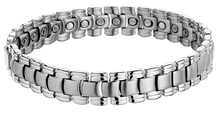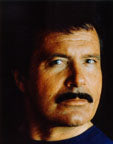Product Description
9T - Wow!! 7/16' Wide & "Too many magnets to count". Whether you like it or not this bracelet will "pump you up." The ultimate light weight magnetic titanium bracelet with a ton of 3300 Gauss north facing neodymium rare earth magnets. How many is "Too Much?"
27, 29 and 31 respectively or 89,100 - 95,700 or a whopping 102,300 Gauss in the XL. This purchase also qualifies for a free cable style bracelet @ checkout($39.95 value). Remember 9T is so strong it will "pump you up." Have some fun get a 9T today - Go with a Winner!!
Max Baer Jr. (above picture inset) - "Jethro" from the Beverly Hillbillies has bought several of our bracelets including this style and he swears by them, (In a Good Way) We Love you too Max!
This item ships the day after you order it and will be at your door within 2-4 days with tracking (when e-mail address is provided @checkout) via USPS priority mail
Max Baer Sr. (The real story versus the movie Cinderella Man)
Max Baer (February 11, 1909 – November 21, 1959) was a famous American boxer of the 1930s, onetime Heavyweight Champion of the World, and actor.
He was born Maximilian Adelbert Baer in Omaha, Nebraska, the son of Jacob Baer (1875-1938) and Dora Bales (1877-1938). His older sister was Fanny Baer (1905-1991), and his younger sister and brother were Bernice Baer (1911-1987) and boxer-turned actor Buddy Baer (1915-1986).
His father was a butcher. The family moved to Colorado before Bernice and Buddy were born. In 1921, when Maxie was twelve, they moved to Livermore, California, to engage in cattle ranching. He often credited working as a butcher boy and carrying heavy carcasses of meat for developing his powerful shoulders.
He turned pro boxer in 1929, progressing steadily through the ranks. A ring tragedy little more than a year later almost caused him to drop out of boxing for good. Baer fought Frankie Campbell (brother of Brooklyn Dodgers Hall Of Famer Adolph Camilli) on August 25, 1930 in San Francisco and knocked him out. Campbell never regained consciousness. After lying on the canvas for nearly an hour, an ambulance finally transported Campbell to a nearby hospital where he eventually died of extensive brain hemorrages. An autopsy revealed that Baer's devastating blows had knocked Campbell's entire brain loose from the connective tissue holding it in place within his cranium. This fatality shocked Baer; according to his son, Max Baer, Jr., he cried and had nightmares over the incident for decades afterwards. He was charged with manslaughter. Although he was eventually acquitted of all charges, the California State Boxing Commission still banned him from any in-ring activity within their state for the next year. He gave purses from succeeding bouts to Campbell's family, but lost four of his next six fights. He fared better when Jack Dempsey took him under his wing, and Baer put Campbell's children through college.
Baer beat the likes of Walter Cobb and Kingfish Levinsky. In 1933, he boxed Max Schmeling (with a Star of David embroidered on his trunks [1], which he swore to wear in every bout thereafter) at Yankee Stadium, dominating the rugged German fighter into the tenth round when the referee stopped the match.
Because he defeated Hitler's favorite, and had some Jewish ancestry, he became a hero to the Jewish people.
His motion picture debut was in The Prizefighter and the Lady (1933) opposite Myrna Loy and Walter Huston. In this MGM movie he played Steven "Steve" Morgan, a bartender that the Professor, played by Huston, begins training for the ring. Steve wins a fight, then marries Belle Mercer, played by Loy. He starts seriously training, but it turns out he has a big ego and an eye for the women. Featured were Bear's upcoming opponent, Primo Carnera, as himself, who Steve challenges for the championship, and Jack Dempsey, as himself, former Heavyweight Champ, acting as the referee.
On March 29, 1934, The Prizefighter and the Lady was officially banned from playing in Germany at the behest of Joseph Goebbels, then Minister of Propaganda and Public Entertainment, even though it received favorable reviews in local newspapers as well as in the Nazi publications.
When an official at the Ministry of Propaganda was asked, "Is the film barred because Max Baer is a Jew?" he snapped, "Ja." When contacted for comment at Lake Tahoe, Baer said, "They didn't ban the picture because I have Jewish blood. They banned it because I knocked out Max Schmeling."
Baer was Heavyweight Champion of the World from June 14, 1934, when he knocked out Primo Carnera, to June 13, 1935, when he lost to Jim Braddock in New York.
He had two wives, actress Dorothy Dunbar (married July 8, 1931-divorced 1933) and Mary Ellen Sullivan (married June 29, 1935-his death 1959). With Sullivan, he had three children, actor Max Baer, Jr. (born 1937), James Baer (born 1941) and Maude Baer (born 1943).
During a separation from his first wife, Max had an affair with movie star Jean Harlow. He fought Lou Nova in the first televised heavyweight prizefight June 1, 1939, on WNBT-TV in New York. His last match was another loss to Nova, in 1941. Baer and his brother, Buddy, both lost fights to Joe Louis, Buddy's two losses to Louis coming in world title fights.
Max Baer boxed in eighty four professional fights from 1929 to 1941. In all, his record was 72-12-0 (53 knockouts), which makes him a member of the exclusive group of boxers to have won fifty or more bouts by knockout.
Baer was an actor in almost twenty movies, including "Africa Screams" with Abbott and Costello, and made several TV guest appearances. A clown in and out of the ring, Baer also appeared in a vaudeville act and on his own TV variety show. He was a disc jockey for a Sacramento radio station and was a wrestler for a while. He was also public relations director for a Sacramento automobile dealership and referee for boxing and wrestling matches.
Unfortunately, Max Baer never saw the TV and movie success of his son, Max Baer, Jr. In November 1959, he was scheduled to appear in some TV commercials, which he planned to do before returning to his home in Sacramento. After refereeing a boxing match in Phoenix, he checked into the Roosevelt Hotel in Hollywood. While shaving in the morning, he had a heart attack and the doctor was called. Baer hung on for a while, but then died in his room at age fifty. He is interred in Saint Mary's Mausoleum, Sacramento.
There is a park named for Max Baer in Livermore, California, which he considered his home town, even though he was born in Omaha.
He was inducted into the Boxing Hall of Fame in 1968, the World Boxing Hall of Fame in 1984 and the International Boxing Hall of Fame in 1995.
Max Baer once said, "I never had a fight out of the ring. I never harmed anyone outside the ring. I loved people."






